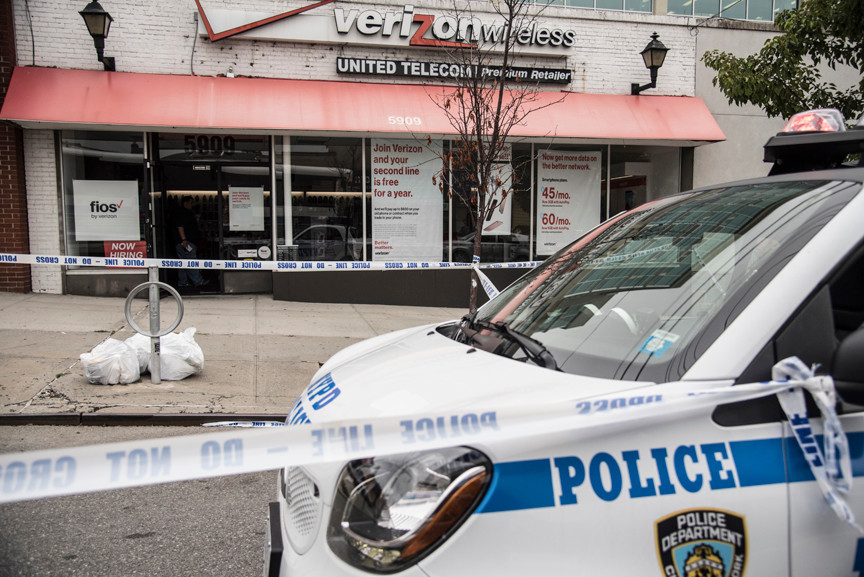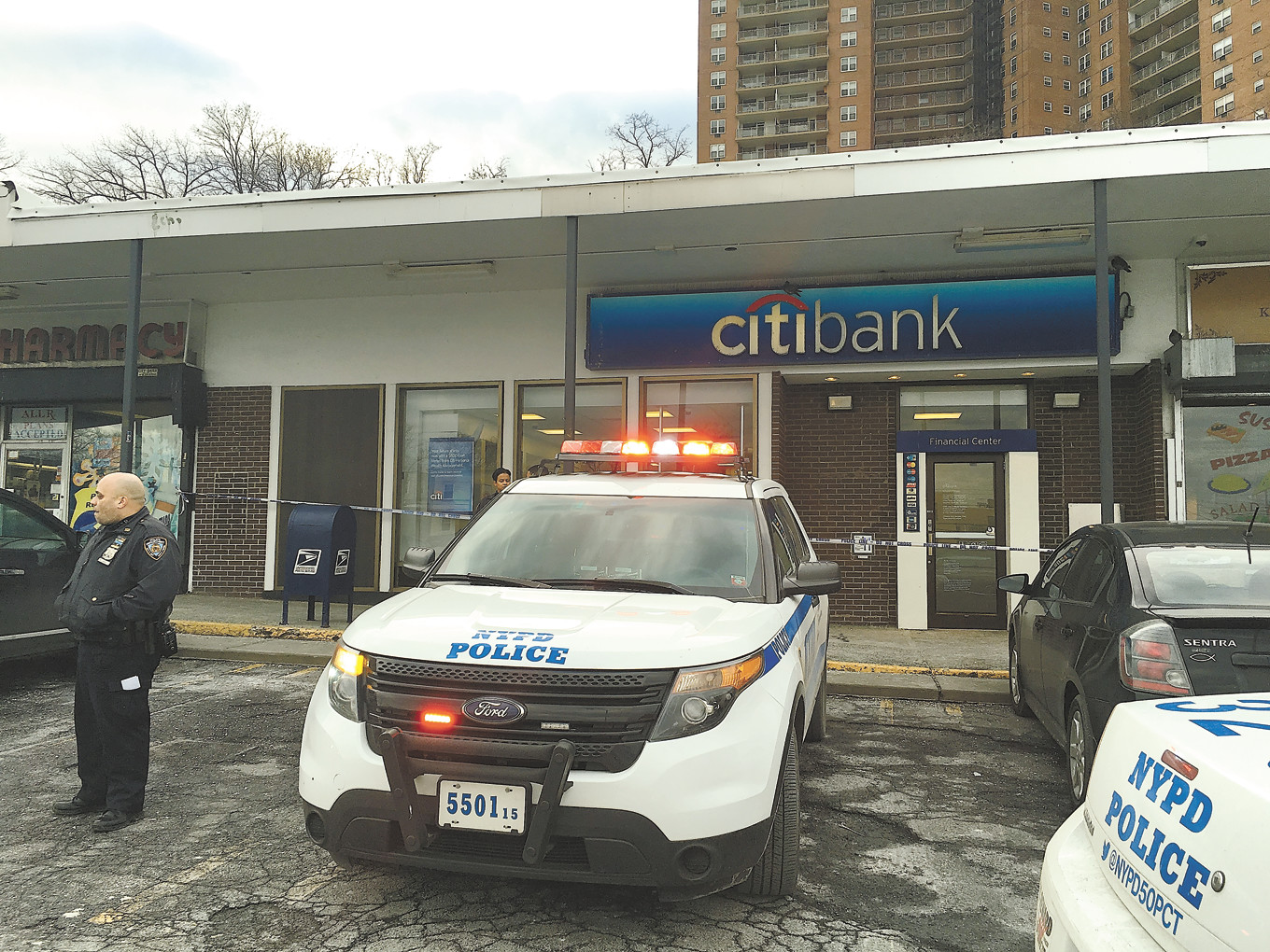Solving crimes in northwest Bronx
The suspects in the bizarre burglary at Riverdale’s Verizon Wireless store this summer were members of an alleged criminal gang based in Upper Manhattan and linked to a series of heists around the city – and Riverdale probably has not seen the last of the burglary team yet, a senior police commander said.
The Press met with Deputy Inspector Terence O’Toole, the commanding officer of the 50th precinct, on Aug. 4 to talk about crime trends and prevention methods. The most memorable cases of the past seven months, intelligence-gathering by the police and crooks, and the effects of digital technologies on new crimes – and on new varieties of age-old crimes – were among the topics of the conversation.
During the Verizon Wireless burglary, five men broke into the store at 5909 Riverdale Ave. at 4:30 a.m. on June 28 and carried out a safe full of smartphones and other gadgets, when the safe cracked open and spilled electronics out on the street. Less than an hour after the break-in, police detained five suspects in Washington Heights, officers said at the time.
The heist and the arrests were the latest in a recent series of similar incidents, Capt. O’Toole said. Another part of the alleged burglary team was arrested in January, 2015.
“They are a team of burglars, gang-based, from Upper Manhattan. [They] were hitting Queens, Brooklyn, the Bronx – not too many in Upper Manhattan,” Capt. O’Toole said. “They would go around in three or four cars, case out a location, figure out who had a safe, who had possibly money there – and hit the place.”
Most of the alleged members of the Upper Manhattan gang are now behind bars – but gangs tend to regrow their networks if any members remain at large.
“There is still one or two people out there, and they will just form up a few more people, and they’ll come back again next year or in a year and a half from now,” Capt. O’Toole said.
Will they come back to Riverdale? “Oh, they probably will,” he said.
The lure of Riverdale’s stores for criminals is not just the inventory – but also the fact that some store owners neglect to upgrade their security systems, even after their stores have been burglarized, Capt. O’Toole said.
Around the time of the Verizon Wireless burglary, three stores on Johnson Avenue were also hit – “and all three stores were the exact same stores that were burglarized last year, and they didn’t upgrade their security – even though they were told they should – but now maybe they’re going to upgrade their security,” he said.
Mail theft
The spread of digital technologies has meant that beside electronics-store burglaries, another type of crime has seen a resurgence recently – mail theft.
After a lull of several decades, thieves are once again trying to make off with mail carriers’ bags, hitting mail vans and “fishing” in mailboxes for envelopes that carry paychecks or private information, such as Social Security numbers.
“There are always good packages on the mail truck – the mailman always brings good things, right?” Capt. O’Toole said, laughing.
Modern software, scanners, printers and the Internet mean that copying and forging checks or stealing victims’ identity has become easier.
“We think of white-collar crime and masterminds. No,” Capt. O’Toole said. “A guy with a sixth-grade education and a computer and an embosser can print up your credit cards.”
Beware of thieves
The single most common type of crime both in the 50th precinct and citywide is grand larceny – any theft of property worth more than $1,000. It stood at 250 cases in the 50th precinct as of July 31 this year, and at 24,855 cases citywide, according to police data. The numbers mark little change from a year ago. But in the 49th precinct – an eastern section of the borough that is demographically similar to the 50th precinct and is also a generally low-crime area – grand larceny rose 19 percent to 268 cases in January-July this year, from 225 cases in the same period last year.
“The problem here is grand larcenies,” Capt. O’Toole said. “People get upset about robberies, they see bank robberies and things like that – those are easy. [But] grand larceny is occurring daily here.”
And investigating it is Capt. O’Toole’s area of expertise: Before taking over command of the 50th precinct, he was leading NYPD grand larceny investigations in Queens and the Bronx.
Some cases involve shoplifting: Going “into Rite Aid down the street and [coming] out with $1,000 worth of stuff from the store isn’t that hard any more,” Capt. O’Toole said. Others involve thieves targeting people who place their purses on shopping carts and look around for groceries – only to find their wallets gone when they turn back. Yet more cases involve laptops and other valuable belongings stolen from cars that owners leave unlocked.
And some more cases involve an increasingly common scam that police have dubbed “collusive account holders,” Capt. O’Toole said.
Those scams usually play out along similar scenarios: A con artist approaches the victim and offers a job – say, in selling vitamins – writes up a check for a few thousand dollars, hands it to the victim and asks for a smaller amount of money back in cash. When the victim tries to deposit the check, it bounces.
“If it sounds too good to be true, it’s not true,” Capt. O’Toole said.
Gathering intelligence
A pin-board at Capt. O’Toole’s office at the precinct house is covered by about 15 printed sheets of paper with photos of recently arrested suspects and brief descriptions of their cases. The faces include those of two young women suspected of burglarizing a U.S. post truck on July 5, in one of the latest cases of mail theft in the precinct.
“These are people we’re going to watch,” Capt. O’Toole said. “When they get out of jail, we’re going to know they are out of jail. We’re not gonna go visit them, but we’ll know they are out, and if they do a robbery that matches their previous robberies, we’ll focus on them.”
The police are looking for “patterns,” he said – two or more crimes that share similar features. That was how most of the burglary team linked to the Verizon Wireless heist were apprehended: “In the case of that burglary team, I think it was 16 crimes altogether,” Capt. O’Toole said.
But as the police watch the criminals, the criminals are watching their victims. Video footage from stores whose customers reported having their wallets stolen showed pairs of thieves – often a man and a woman, or two women – shadowing their intended victims before making a move, Capt. O’Toole said.
In other cases, such as the Verizon Wireless burglary, thieves seemed to be acting on detailed intelligence about the store’s layout and inventory. Video footage from one of the stores the Upper Manhattan team is suspected of burglarizing showed thieves walking in, heading directly for the safe, loading it on a dolly or a similar device from the store and wheeling out the loot, he said.
Verizon Wireless burglars also seemed to have “some type of inside connection,” he said, although the police have never figured out what it was.
“Maybe they were delivery men, maybe they were regular customers – we don’t know, but we believe there was some situation, that they knew what was going on there,” he said.
And while the thieves have been going high-tech – whether by stealing electronic devices, or using them to forge checks and steal identities – the police are bringing in new technologies to solve those crimes.
The 50th precinct has installed its first street camera on the corner of W. 197th Street and Sedgwick Avenue to monitor what officers consider a high-crime area, and more cameras are coming within a year, Capt. O’Toole said.
The cameras are funded by allocations from Bronx city council members, and each installation costs about $70,000 to $75,000. That is a hefty chunk of money, but the price includes protecting the camera from vandals, setting up a data feed to the NYPD, and the costs of storing information for about three years, Capt. O’Toole said.
“As these cameras come online, they will be connected to the NYPD fiber-optic network, and we’ll be able to view them right here, at the desk,” he said. “The technology is advancing rapidly.”
-
Related story: Recent crime trends and what they mean









